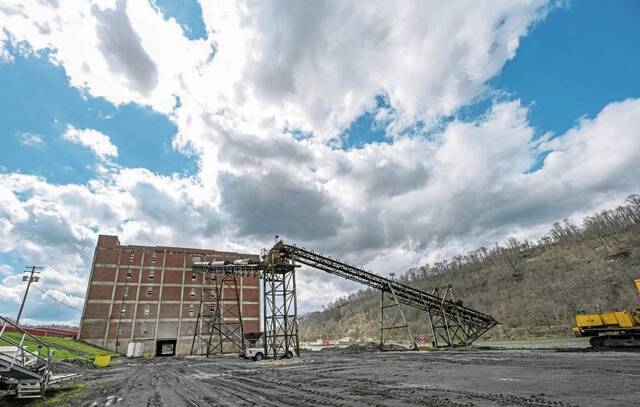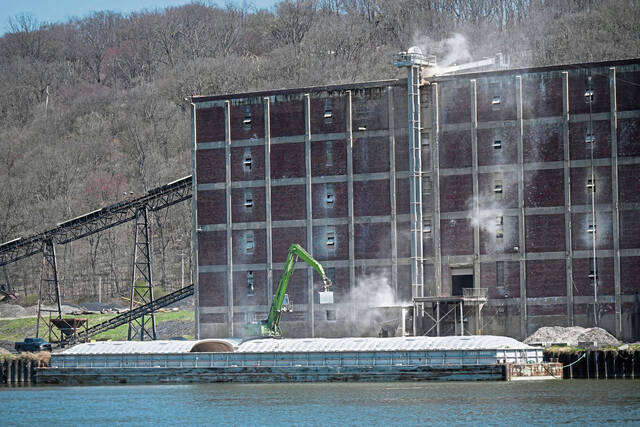New $3M barge dock planned along the Allegheny River in Gilpin
A deteriorating steel dock along the Allegheny River in Gilpin is showing its age but has promise to be a boon to the local economy.
Located in the township’s Schenley section, at milepost 30.8 on the Allegheny River north of Pittsburgh, it’s the last commercial dock going upriver from the city.
Its owner, Armstrong Terminal Inc., plans to replace the dock this year, which would increase its ability to serve barge traffic and expand business capabilities in the area. A $1 million state grant is helping to make that happen.
The money comes from the state Commonwealth Financing Agency through its Multimodal Transportation Program.
The dock, installed during the 1940s, is succumbing to the river, weather and industrial usage. It isn’t meeting the needs of Armstrong Terminal, a full-service bulk material handling and storage facility processing all types of dry-bulk materials for the fertilizer and animal feed markets.
The dock is inside Schenley Industrial Park, home to the former Schenley Distilling Co., once the largest distillery in the country.
Other park tenants include Senjan Machine Inc.; the Schenley Yacht Club; and BPI Inc., an industrial minerals supplier.
Armstrong Terminal depends on barges and trucks for distribution of goods to the Northeast, Midwest, South and Mid-Atlantic regions.
Samuel Lansberry II, Armstrong Terminal owner, said he is grateful for the money that will help pay for the estimated $3 million project.
“Our dock is in dire need of rehabilitation,” Lansberry said. “These grant funds will allow us to undertake the rehabilitation effort. This will allow us to continue handling barge traffic on the Allegheny River while continuing to contribute to the success of Armstrong County.”
Currently, Armstrong Terminal schedules about one barge per week. It can take from one to three days to unload a barge.
Armstrong Terminal is required to pay for 30% of the project. The company has applied for one more multimodal PennDOT grant, which is still outstanding.
Lansberry said bids haven’t been solicited because he only heard the news of the grant last week.
Officials hope improvements will foster greater economic growth and improve local transportation infrastructure in Armstrong County.
“When completed, the new dock is expected to be able to accommodate double the current load, which will increase their workforce and the safety of the docking area,” said Gilpin Supervisors Chairman Charles Stull. “I put the full support of Gilpin Township behind the project.”
David Finken, manager of Armstrong Terminal, said he expects barge traffic to double — from 50 to 100 per year.
Armstrong Terminal relies on barges as its most cost-effective mode of transportation.
One barge can haul what would take about 70 tractor-trailers to handle, Finken said.
“We’re operational now but you can see it’s not flat, not level, and we unload with a clam shell bucket and excavator and that makes it easier,” Finken said.
Last year, Armstrong Terminal began exporting animal grains, mulch, stone, salt and more.
“We’re looking to develop more of that,” Finken said.
Armstrong Terminal opened in 1991 and is a subsidiary of Lansberry Trucking of Clearfield County.
“I think we can really grow this and make something special,” Finken said. “But it’s gonna take an investment, even with the state’s help.”
The project will have two phases and is expected to take less than a year.
Phase I will repair 400 feet of the dock’s 700-foot length. The new steel dock will be installed in front of the current one.
The dock, just upriver from Lock and Dam 5, originally was built to help prevent flooding and is washed out in sections. Its wall is crooked and leaning, with wire cable holding it together in certain areas.
“A barge is 200 feet straight and it’s moving back and forth (with the uneven dock), and that takes time to get to it,” Finken said. “This is the last dock for commercial businesses still going through, and it’s basically been packed down for 80 years or more due to usage — and it’s not designed for what we do.”
Since 2011, the four locks upstream of Lock 5 only operate on select summer weekends to accommodate recreational boaters.
It takes about eight hours for a barge to travel from Pittsburgh to the dock in Schenley.
Local and state officials have lobbied for the project since discussions about it started last year.
Gilpin sent letters of support for the project. Sen. Joe Pittman, R-Indiana; and state Reps. Abby Major, R-Leechburg, and Donna Oberlander, R-Clarion, threw in their support.
“The Allegheny River plays a key role in our region’s economy. These upgrades will not only benefit commercial traffic but also recreational boating. The river draws visitors and businesses to our community. I’m happy to support this project,” Major said.
The Allegheny River has eight locks in total, all fixed-crest dams.
“We guarantee industry there will be at least a 9-feet-deep draft in the navigable channels so loaded barges won’t drag on the bottom of the river,” said Alan Nogy, Army Corps of Engineers lock and dam branch chief lockmaster, based at Neville Island.
Lock 5 averages 130 commercial uses, transporting 52,000 tons of commodities, annually. The lock averages about 355 recreational uses, totaling about 576 vessels, Nogy said.
“There are no lockage fees, and we’re funded by the federal government, so there is a pecking order,” said Nogi of the order in which vessels may navigate the locks and dams.
Government vessels get first priority; followed by commercial boats, such as the Gateway Clipper, that have time restrictions; then commerical traffic, such as barges and tow boats; and lastly recreational boats.
Lock 5 is open for 10 hours daily. Locks 6, 7, 8 and 9 offer limited service by appointment only because of the lack of commerical development along the river, Nogi said.
Joyce Hanz is a native of Charleston, S.C. and is a features reporter covering the Pittsburgh region. She majored in media arts and graduated from the University of South Carolina. She can be reached at jhanz@triblive.com
Remove the ads from your TribLIVE reading experience but still support the journalists who create the content with TribLIVE Ad-Free.





